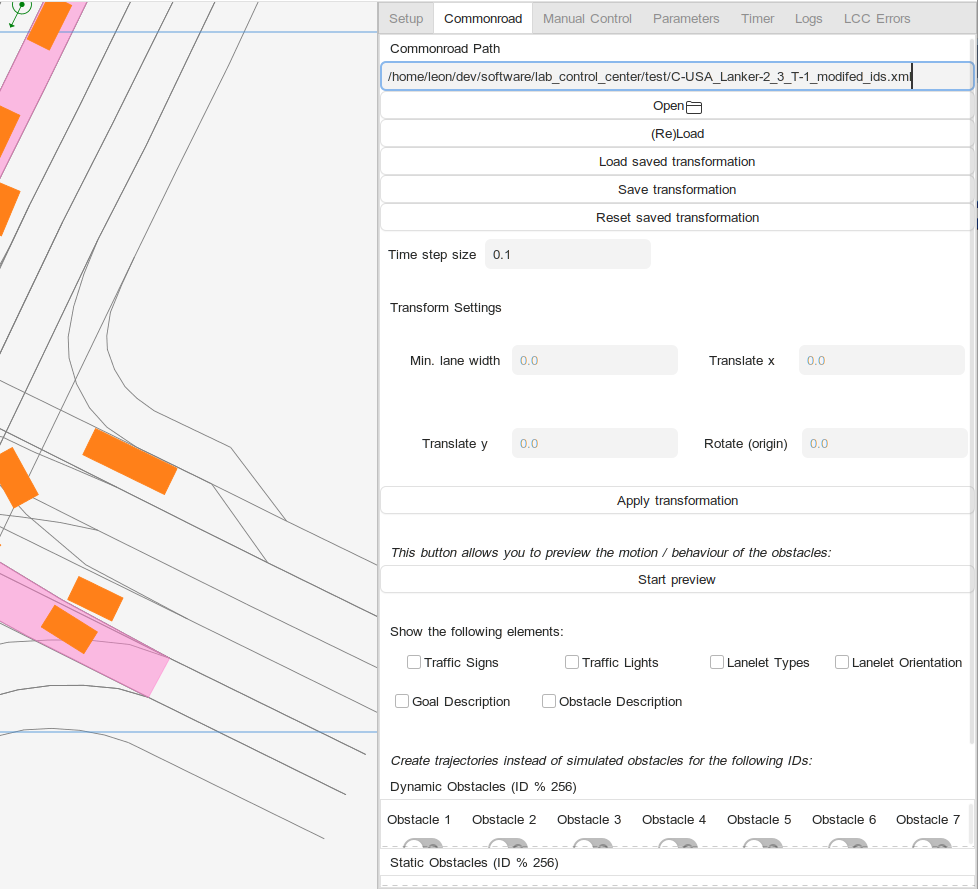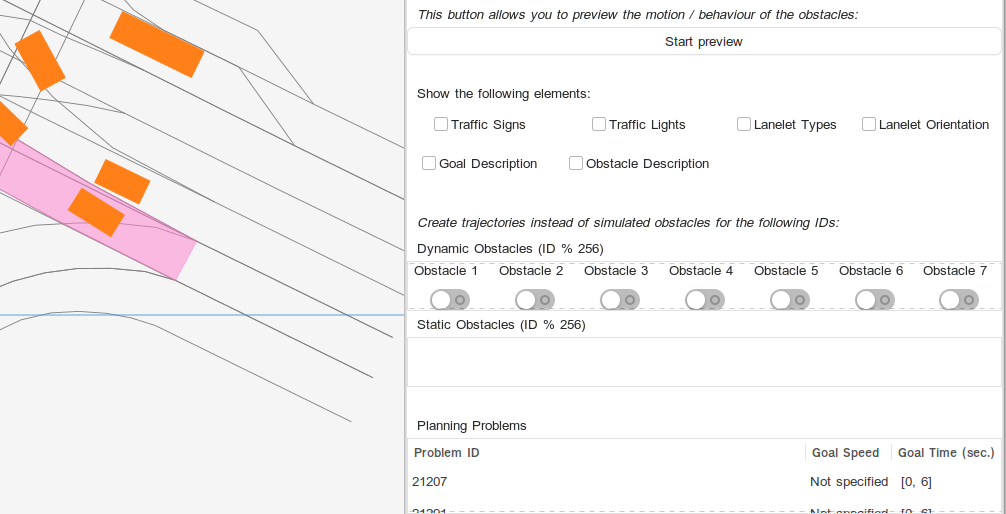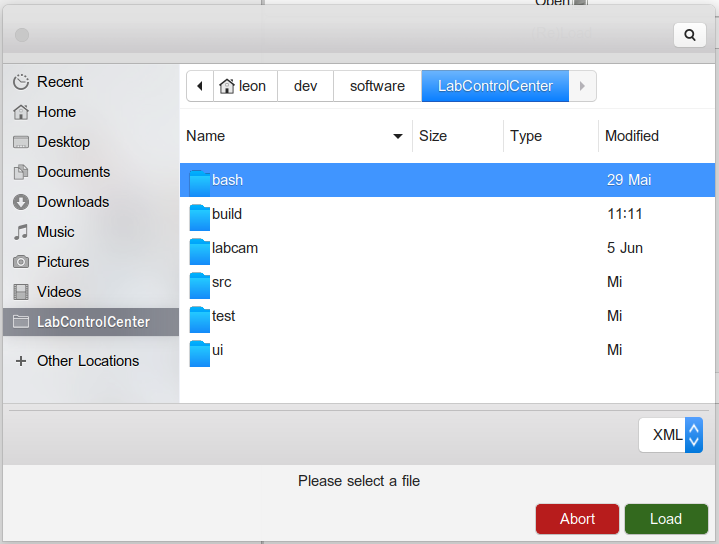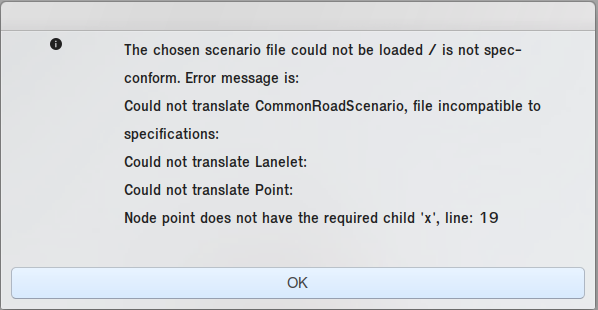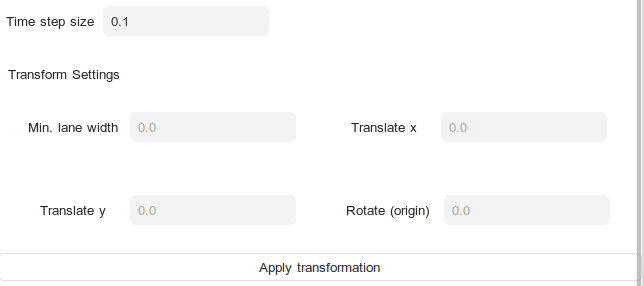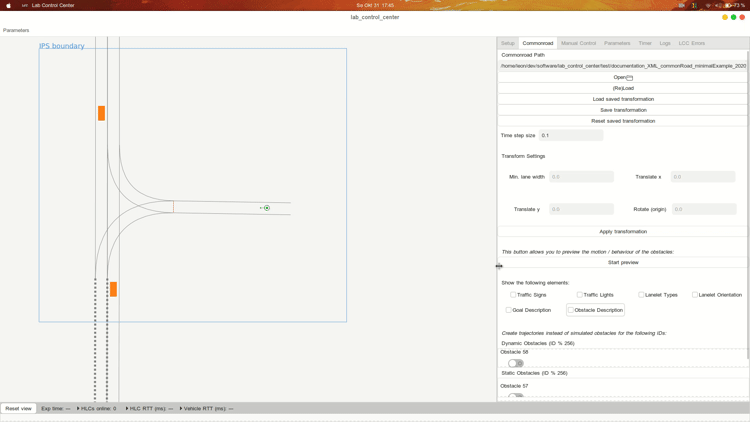Elements in this tab allow the user to load and transform Commonroad scenarios which follow the 2018 or 2020 specifications. The scenario will then be drawn in the MapView of the LCC and obstacles will either be simulated or used to control real vehicles with VehicleCommandTrajectory messages. (TODO:) Planning problems, obstacles etc. defined in the scenario will be used for the simulation and will be communicated to the participants when the simulation is started in Setup.
The tab also shows some basic information about the set planning problems, allows to transform the problem (and to store that transformation) and gives options on what elements of the problem to show.
Choosing a Scenario
A scenario can be chosen similarly to the script selection in Setup. Either use the Open button or edit the path text field and hit Enter.
Commonroad Specification
We have not (yet) implemented the whole commonroad specification. Intersections, crossings, and signals are currently being ignored and print warnings visible in the LCC Errors Tab. Traffic lights are not being simulated, but their position is shown, if possible.
We also do not (yet) have a consistent handling of inexact positional values (we currently use the average) and rotations for shapes. The assumed default value for positions is (0,0) (origin).
Your chosen scenario gets centered when it is loaded, w.r.t the middle of the Lab's IPS boundaries. It is not automatically resized, though, so you might not see the whole scenario when you load it.
Error Messages
Upon loading a scenario. you might receive an error message. Parts of the implemented loader check your scenario for consistency with the Commonroad specification. If it is malformed, values are missing or wrong types are used, you will find that the scenario will not load. Instead, a window will appear, which refers you to the line (in your scenario file) that raised the error.
IMPORTANT: There are also less relevant errors, e.g. related to drawing, which might be caused by currently missing implementation or decisions made on which Commonroad types to support. These error messages are shown in the LCC Errors Tab and will not prevent your scenario from loading. Keep in mind that these parts of the scenario might then not be supported in the simulation and also might not show up on the screen.
Transforming the Scenario
You can also transform your scenario:
- Resize it by setting a minimum lane width
- Translate its x or y coordinates
- Rotate it around its center
- Change the time steps
Just enter the desired values in the according text boxes and either hit Enter if you just want to change one value, or set values for multiple fields first before applying them by clicking on Apply transformation. The values in the fields are set to 0.0 again after the transformation was applied.
IMPORTANT: The scenario gets centered when it is first loaded, as the set coordinates might be out of scope. This means, if your scenario only uses coordinates e.g. larger than 200 for x and y values, it should still show up in the MapView. The current centering is not perfect, so you may want to translate it further.
Transformation Profile
You might be interested in keeping the transformation that you set for your scenario. We use a YAML profile to accomplish this. You do not need to access it directly:
- Load saved transformation This button applies transformations that you have stored before to the currently loaded scenario. Important: It does not reset changes made before, so you might want to (Re)Load before pressing this button.
- Save transformation Save the current transformation in the profile for your current file. Important: Changes in x / y are added, not overwritten.
- Reset saved transformation Resets the transformation profile for the current file. Important: This also includes the initial centering that takes place automatically, and every transformation you have done so far. It is thus advisable to (Re)Load after performing a reset.
Rotation is not being stored. It is the only operation where the order truly matters, and it is also non-linear. It was thus left out for now.
Scenario Preview
If you want to see what the scenario looks like during the simulation, you can preview the movement of the obstacles from within the Commonroad Tab:
Toggle Additional Information
We did not want the view to become too cluttered. Thus, parts of the simulation like traffic signs or vehicle information are only drawn on demand. They can be toggled in this part.
Obstacles and IDs
The loaded Commonroad scenario may define obstacles. The obstacle ID set in Commonroad is interpreted as the ID of the vehicle in the scenario. This is especially important if you choose to use the movement defined for the obstacle to be used as trajectory for a real vehicle. In this case, the real vehicle with the same ID will respond to the message.
In the image above, the path of obstacle 1 is communicated in form of trajectory messages for vehicle 1 - which can also be received and followed by a real vehicle - while the other obstacles are simulated without controlling real vehicles.
We only allow for obstacle IDs up to 256 due to the message types in use (uint8_t for ID) (TODO?), thus the ID is taken mod 256 if it is higher than that - we do not expect that you need to use more than 256 obstacles within one scenario (this might also have bad consequences for the performance of a simulation).
Goal Information
Additional information about the goal states are shown at the bottom of the Commonroad-Tab.
Using Commonroad as Part of the Simulation
To actually see / use the obstacle simulation, you need to:
- Click Deploy in the Setup Tab
- Switch to the Timer Tab and press Start
This should be your usual workflow for starting your own script via the LCC as well.
Further information
We use different color codings for inexact positions of drawn obstacles, where obstacles with exact positions are orange.
The descriptions for obstacles use few latters to save space. Their meaning is explained here:
| Symbol | Meaning |
|---|---|
| E | Pose is exact |
| I | Pose is not exact |
| M | Obstacle is moving |
| S | Obstacle is static |
| Unk | Unknown obstacle |
| Car | Obstacle is a car |
| Truck | Obstacle is a truck |
| Bus | Obstacle is a bus |
| MCycle | Obstacle is a motorcycle |
| BCycle | Obstacle is a bicycle |
| Ped | Obstacle is a pedestrian |
| Prio | Obstacle is a priority vehicle |
| Train | Obstacle is a train |
| Constr | Obstacle is a construction zone |
| Parked | Obstacle is a parked vehicle |
| Boundary | Obstacle is a road boundary |
The text drawn for traffic signs is taken from its definition in the commonroad file:
Traffic Sign ID (list of additional values) Traffic Sign ID (list of additional values) Traffic Sign ID (list of additional values) ...
